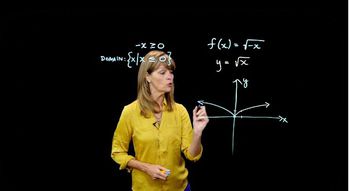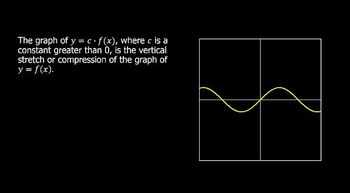Table of contents
- 0. Review of Algebra4h 16m
- 1. Equations & Inequalities3h 18m
- 2. Graphs of Equations43m
- 3. Functions2h 17m
- 4. Polynomial Functions1h 44m
- 5. Rational Functions1h 23m
- 6. Exponential & Logarithmic Functions2h 28m
- 7. Systems of Equations & Matrices4h 6m
- 8. Conic Sections2h 23m
- 9. Sequences, Series, & Induction1h 19m
- 10. Combinatorics & Probability1h 45m
3. Functions
Transformations
Problem 107
Textbook Question
In Exercises 107-118, begin by graphing the cube root function, f(x) = ∛x. Then use transformations of this graph to graph the given function. g(x) = ∛x+2
 Verified step by step guidance
Verified step by step guidance1
<Step 1: Understand the parent function.> The parent function here is \( f(x) = \sqrt[3]{x} \). This is the cube root function, which has a characteristic shape that passes through the origin (0,0) and is symmetric about the origin.
<Step 2: Graph the parent function.> Plot the graph of \( f(x) = \sqrt[3]{x} \). It will have a gentle S-shape, increasing from left to right, passing through the origin, and extending infinitely in both directions.
<Step 3: Identify the transformation.> The given function is \( g(x) = \sqrt[3]{x} + 2 \). This represents a vertical shift of the parent function. The '+2' indicates that the entire graph of \( f(x) = \sqrt[3]{x} \) will be shifted upwards by 2 units.
<Step 4: Apply the transformation.> Take each point on the graph of \( f(x) = \sqrt[3]{x} \) and move it up 2 units. For example, the point (0,0) on \( f(x) \) will move to (0,2) on \( g(x) \).
<Step 5: Graph the transformed function.> Draw the new graph of \( g(x) = \sqrt[3]{x} + 2 \) using the points obtained from the transformation. The graph will maintain the same shape as \( f(x) = \sqrt[3]{x} \) but will be shifted upwards by 2 units.
Recommended similar problem, with video answer:
 Verified Solution
Verified SolutionThis video solution was recommended by our tutors as helpful for the problem above
Video duration:
1mPlay a video:
Was this helpful?
Key Concepts
Here are the essential concepts you must grasp in order to answer the question correctly.
Cube Root Function
The cube root function, f(x) = ∛x, is a fundamental mathematical function that returns the number whose cube is x. It is defined for all real numbers and has a characteristic S-shaped curve that passes through the origin (0,0). Understanding its basic shape and properties is essential for graphing transformations.
Recommended video:

Imaginary Roots with the Square Root Property
Graph Transformations
Graph transformations involve shifting, stretching, compressing, or reflecting the graph of a function. In this case, the transformation applied to the cube root function to obtain g(x) = ∛(x + 2) is a horizontal shift to the left by 2 units. Recognizing how these transformations affect the graph is crucial for accurately sketching the new function.
Recommended video:

Intro to Transformations
Function Notation
Function notation, such as f(x) and g(x), is a way to represent functions and their outputs. It allows for clear communication of the relationship between input values (x) and their corresponding outputs (f(x) or g(x)). Understanding function notation is vital for interpreting and manipulating functions correctly in algebra.
Recommended video:

Interval Notation

 5:25m
5:25mWatch next
Master Intro to Transformations with a bite sized video explanation from Nick Kaneko
Start learningRelated Videos
Related Practice

























